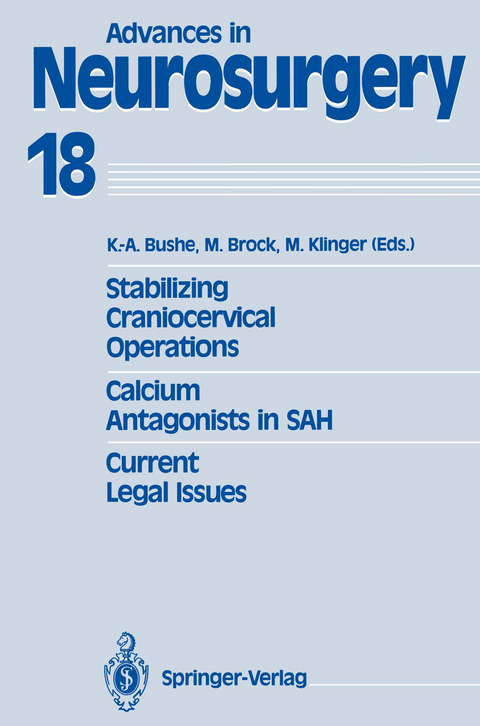Stabilizing Craniocervical Operations Calcium Antagonists in SAH Current Legal Issues
Springer Berlin (Verlag)
978-3-540-51967-6 (ISBN)
Reflections on the Future of German Neurosurgery: Further Development on the Foundations Laid by Tönnis.- Decompression and Stabilization of the Cervical Spine.- Indications and Complications of Cervical Spine Stabilization.- Osteosynthesis of the Upper Cervical Spine and the Craniocervical Junction.- Surgical Treatments to Stabilize the Upper Cervical Spine.- The Caspar Plate as a Means of Stabilizing the Upper, Middle, and Lower Cervical Spine - Results in 45 Cases.- Anterior Reconstruction and Stabilization After Cervical Vertebral Body Resection.- Long-Term Results After Cervical Interbody Fusion with Polymethylmethacrylate.- Cervical Spine Injuries in Childhood: Long-Term Results After Surgical and Conservative Therapy; Morphological and Functional Aspects.- Bracing of the Dens Axis.- The Surgical Treatment of Atlas, Axis, and Combined CI and C2 Fractures.- Association of Injuries to the Head and Spine: 34 Consecutive Cases over a 3-Year Period.- Operative Treatment of Metastatic Cervical Spine Instability.- On the Symptomatology and Neurosurgical Treatment of Senile Ankylosing Hyperostosis of the Spine (Forestier).- Cervical Spine Fractures in Ankylosing Spondylitis - An Imperative Indication for Surgical Spondylodesis.- Primary Autologous Bone Transplantation in the Treatment of Cervical Spondylitis.- Treatment of Craniocervical Instabilities with the Halo-fixateur.- The Natural History of Unstable Traumatic Injuries of the Cervical Spine.- Syringomyelia.- Evolution of the Neurosurgical Management of Syringomyelia in the Last Two Decades.- Syringomyelia: Aspects of Therapeutic Decisions.- Pathogenesis and Operative Treatment of Syringomyelia.- Magnetic Resonance Imaging of Syringomyelia: Idiopathic and Tumor-Associated Cases.- Comparison of Syringoperitonealand Syringopleural Shunting in Patients with Syringomyelia.- Microsurgical Treatment of Syringomyelia: Intraoperative Findings and Results.- SEPs and Evoked Muscle Responses After Noninvasive Magnetic Stimulation in Patients with Syringomyelia.- Lumbosacral Lipomas and Lipomyelomeningoceles: Operability and Long-Term Follow-up.- The Optimal Time for Operative Treatment of the Tethered Cord Syndrome.- Tethered Cord Syndrome Following Spina Bifida Aperta.- Intraspinal Lipomas with Tethered Cord Syndrome - Results of Operative Treatment in 30 Children.- The Use of Calcium Antagonists Following Subarachnoid Hemorrhage.- Pharmacology of Nimodipine - A Review.- The Prognostic Significance of the Concentration of Nimodipine in the CSF and Plasma in Subarachnoid Hemorrhage.- Is High Dose Nimodipine Therapy Necessary Following Subarachnoid Hemorrhage? A Retrospective Study of 80 Patients with Aneurysmal Subarachnoid Hemorrhage over the Past 2 Years.- Interactions Between Nimodipine and Anesthetics Used in Neurosurgical Procedures.- Influence of Nimodipine on Pulmonary Function.- Tolerability of Calcium Antagonists.- Nimodipine in the Treatment of Subarachnoid Hemorrhage Secondary to Aneurysm Rupture: Five Years' Experience.- Experience with Deliberate Early Aneurysm Surgery and Nimodipine.- Effect of Nimodipine on the Outcome Following Operation for Ruptured Intracranial Aneurysms.- Parenteral Nimodipine Therapy After Subarachnoid Hemorrhage: A Randomized Clinical Study.- Postoperative Long-Term Results After Aneurysm Surgery Among Patients Treated with Nimodipine.- The Acute Effect of Nimodipine on Intracranial Pressure and Cerebral Blood Flow.- Clinical Significance of TCD Pulsatility Indices in Subarachnoid Hemorrhage and Arteriovenous Malformations.- Development ofVasospasm After Subarachnoid Hemorrhage Under Nimodipine Therapy Before and After Aneurysm Surgery.- Prevention of Vasospasm with Nimodipine.- The Clinical Value of Transcranial Doppler Sonography in Aneurysmal Subarachnoid Hemorrhage as an Indication for Cerebral Angiography and a Means of Controlling Nimodipine Treatment.- Clinical and Transcranial Doppler Sonography Evaluation During Treatment with Calcium Antagonists After Subarachnoid Hemorrhage.- CBF Dynamics - Vasospasm After Subarachnoid Hemorrhage.- Discrepancy Between the Results of TCD and the Clinical Status of Patients After SAH.- Aktuelle Rechtsfragen in der Neurochirurgie in Forschung und Klinik.- Current Legal Issues in Neurosurgical Research and Treatment.- Zur Verwendung menschlichen Gewebes, insbesondere von foetalem Gewebe in der Neurochirurgie.- Risiko und erforderlicher Standard in der Neurochirurgie - Überholtes, Notwendiges, Unerprobtes - (Neurochirurgisches Referat).- Risiko und erforderlicher Standard in der Neurochirurgie - Überholtes, Notwendiges, Unerprobtes - (Juristisches Referat).- Neuere Entwicklung in der Rechtsprechung zur Aufklärung.- Die ärztliche Aufklärung - Eine Gratwanderung zwischen juristischem Muß und ärztlichem Tun?.- Straf- und zivilrechtliche Aspekte neurochirurgischer Tätigkeit.- Erfahrungen einer "Gutachterkommission für Ärztliche Behandlungsfehler" mit Behandlungsfehlern im neurochirurgischen Fachgebiet.- Sorgfaltsmangel oder typische Komplikation - Auswertung der Begutachtungen für die Schlichtungsstelle für Arzthaftpflichtfragen unter besonderer Berücksichtigung der Bandscheibenoperation.- Zur Begutachtung von traumatischen Hirnschlagaderverletzungen.- Kann ein Schädelhirntrauma ein Akustikusneurinom auslösen? RechtsmedizinischeÜberlegungen anhand eines Falles.- Gibt es histologische Beweise für eine traumatisch bedingte Bandscheibenschädigung?.- Versicherungsrechtliche Bewertung von Traumen für die Entstehung und den Verlauf zervikaler und lumbaler Bandscheibenvorfälle.- Eine seltene Komplikation nach Bandscheibenoperation in Knie-Ellenbogenlage.- Gesprächsführung in der Neurochirurgie.- Gutachtertätigkeit in Sozialgerichtsverfahren.- Notwendigkeit und Voraussetzungen einer Gebrechlichkeitspflegschaft bei neurochirurgischen Patienten.
| Erscheint lt. Verlag | 18.5.1990 |
|---|---|
| Reihe/Serie | Advances in Neurosurgery |
| Zusatzinfo | XXV, 374 p. 100 illus. |
| Verlagsort | Berlin |
| Sprache | englisch |
| Maße | 155 x 235 mm |
| Gewicht | 695 g |
| Themenwelt | Medizinische Fachgebiete ► Chirurgie ► Unfallchirurgie / Orthopädie |
| Medizin / Pharmazie ► Medizinische Fachgebiete ► Neurologie | |
| Schlagworte | Decompression • Ellenbogen • instability • Kalziumantagonist • Medizinische Gutachten • Neurochirurgie • Neurologie • neurosurgery • Schädelhirntrauma |
| ISBN-10 | 3-540-51967-X / 354051967X |
| ISBN-13 | 978-3-540-51967-6 / 9783540519676 |
| Zustand | Neuware |
| Haben Sie eine Frage zum Produkt? |
aus dem Bereich




